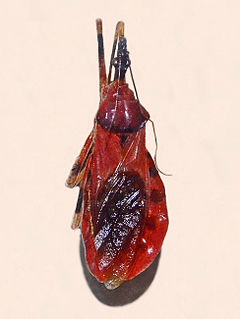Vitumnus is a genus of assassin bugs, in the subfamily Harpactorinae.

Rhodnius is a genus of assassin bugs in the subfamily Triatominae, and is an important vector in the spread of Chagas disease. The Rhodnius species were important models for Sir Vincent Wigglesworth's studies of insect physiology, specifically growth and development.
Domnus is a genus of assassin bug, in the subfamily Harpactorinae.

The Harpactorinae are a large subfamily of the Reduviidae. About 300 genera and 2,000 species worldwide have been described. Some of the species of the genera Zelus, Pselliopus, Sinea, and Apiomerus are of interest as biological pest control agents.

The Ectrichodiinae are a subfamily of assassin bugs (Reduviidae) known for specializing on millipedes as prey. The group comprises more than 600 species in about 115 genera, making it a fairly large subfamily. The bugs are also known for their aposematic coloration, often brightly colored metallic blue, red, or yellow.

Harpactorini is a tribe of the Harpactorinae. This group is the most diverse of the entire assassin bug family, with 51 genera recognized in the Neotropical Region and 289 genera and 2003 species overall.

Sphedanolestes is a large genus of assassin bugs in the family (Reduviidae), subfamily Harpactorinae. There are more than 190 described species, which are found in southern Europe, Africa and Asia.

Harpactor is a genus of assassin bug family (Reduviidae), in the subfamily Harpactorinae.

Rhynocoris is a genus of assassin bug, family (Reduviidae), in the subfamily Harpactorinae. Species are recorded from Asia, mainland Europe, Africa and North America.

The Stenopodainae are a subfamily of Reduviidae. Many species of this subfamily are endemic to tropical rainforests, and some smear their fore legs with sticky, plant-derived resin, to aid in prey capture.

The Reduviinae are a subfamily of the reduviid assassin bugs. Many members of the subfamily are nocturnal and their lifecycles are generally poorly known. This subfamily is suspected not to be monophyletic.
Gardena insperata is a thread-legged bug species from the genus Gardena. It is found in Tadjikistan and Afghanistan.
Irantha is a small and little-known genus of assassin bug family (Reduviidae), in the subfamily Harpactorinae. Just four species have been described.
Tiarodes is a genus of assassin bugs. Eighty-five species are known.

Acanthaspis is a genus of assassin bugs. Members of the genus are known to disguise themselves by attaching bits of debris to aid in camouflage.

LopodytesRondani 1867 is a genus in the family Reduviidae, the assassin bugs. Members of the genus have been unofficially assigned the common name Grass Assassin bugs, but generally this name remains meaningful only to naturalists, because these insects have been too well camouflaged to raise robust public awareness.

Eulyes is a genus of true assassin bugs belonging to the family Reduviidae.

Glymmatophora, the Metallic Assassin Bugs, is a genus of assassin bugs belonging to the family Reduviidae.
Psyttala is a genus of insects belonging to the assassin bugs. The name is commonly misspelled as Psytalla (e.g.).

Nagusta is a genus of Murder bugs in the family Reduviidae.











